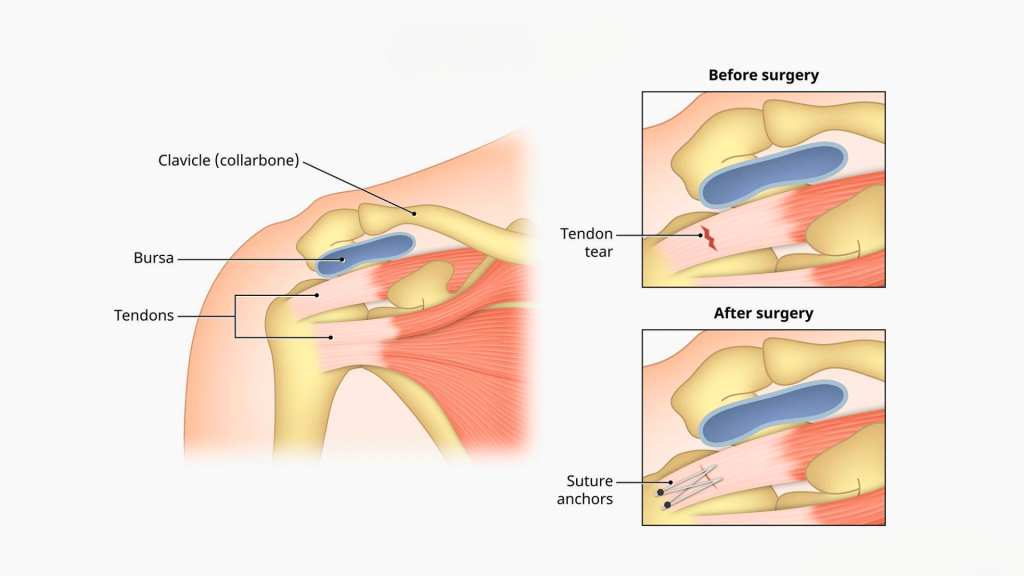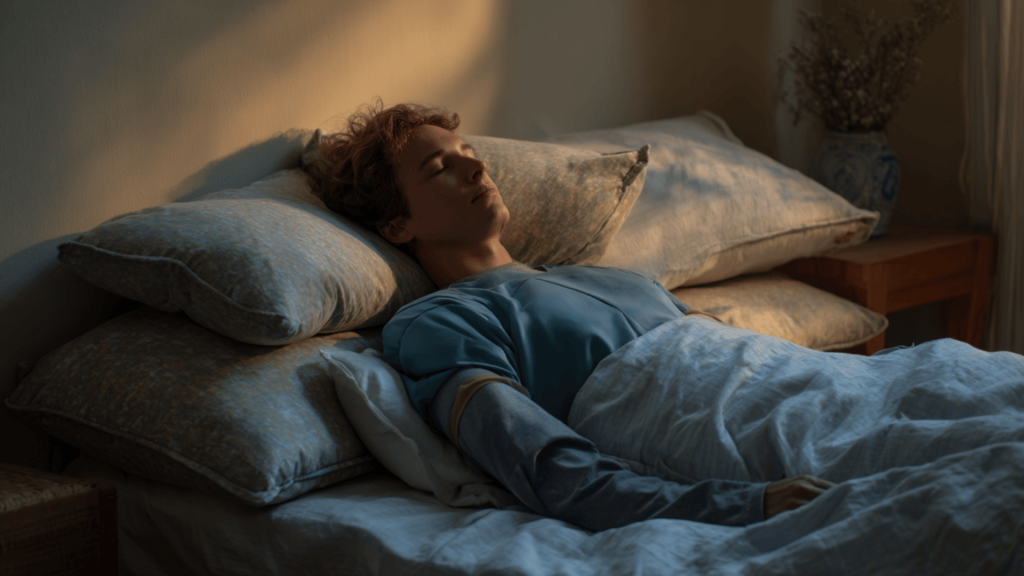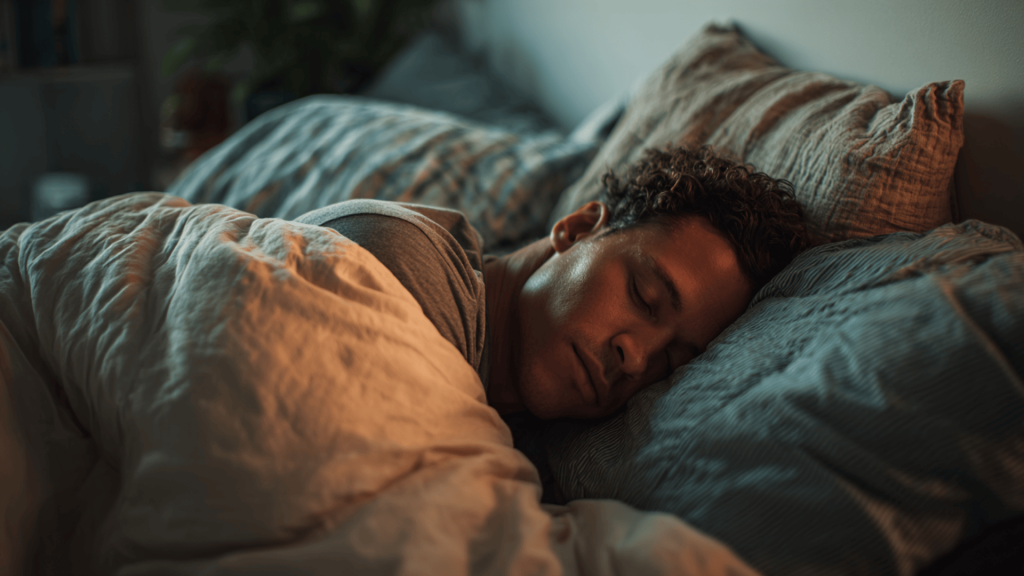After shoulder surgery, even simple things, like getting comfortable at night, can feel nearly impossible.
I remember wondering the same thing you might be asking now: when can I sleep on my side after shoulder surgery? It’s a common concern, and it’s an important one, because rolling too soon can slow down your healing.
I’ll walk you through what to expect: when it’s usually safe to return to side sleeping, which positions are easiest on your shoulder, and which tools can help make sleep more restful during recovery.
By the end, you’ll feel more confident about how and when to ease back into side sleeping without setting yourself back.
When Can I Sleep on My Side After Shoulder Surgery?
Most people can safely sleep on their side again about 4 to 6 weeks after shoulder surgery.
But everyone heals at a different pace. Your surgeon’s advice always comes first. They’ll let you know when your shoulder is stable enough.
Here’s a quick look at side-sleeping timelines based on surgery type:
| Surgery Type | When You Can Usually Sleep on Your Side |
|---|---|
| Arthroscopic shoulder surgery | Around 4 weeks |
| Rotator cuff repair | 6 to 8 weeks or more |
| Total shoulder replacement | About 6 weeks, depending on recovery |
| Reverse shoulder replacement | Often 6 to 8 weeks |
Check in with your doctor before changing your sleep position. It’s the best way to stay safe and avoid setbacks.
Why Side Sleeping is a Concern After Shoulder Surgery
Sleeping after shoulder surgery can be tricky, especially in the first few weeks. Your body needs time to heal, and the wrong position can slow things down or cause pain.
Here’s why side sleeping can be a problem early in recovery:
- Too much pressure on the healing shoulder: This can cause pain, swelling, or damage to the repaired area.
- Limited support for the joint: Without good alignment, your shoulder might shift or move while you sleep.
- Increased risk of re-injury: Turning onto your side by accident can stress the joint or surgical site.
- Poor sleep quality: Pain or discomfort from sleeping incorrectly can make it hard to rest well, which slows healing.
That’s why most doctors recommend a reclined or supported position when sleeping after shoulder surgery. It keeps your joint protected and helps you rest more comfortably while you recover.
Different Types of Shoulder Surgery and Recovery Impact

Each type of shoulder surgery affects your sleep recovery timeline differently. Some surgeries need more healing time, which can delay when you’re able to sleep on your side.
Below is a quick breakdown of common surgeries and how they might impact sleeping after shoulder surgery:
Rotator Cuff Repair
- Often needs the longest recovery.
- Side sleeping may not feel safe until 6–8 weeks post-op.
- Extra care is needed to avoid re-tearing the tendon.
Total Shoulder Replacement
- Requires more healing due to the joint replacement.
- Most patients can start side sleeping around 6 weeks, with support.
- Sleeping flat or on the operative side too early can strain the joint.
Reverse Shoulder Replacement
- Usually done for severe damage or arthritis.
- Side sleeping may take up to 8 weeks or longer.
- Stability is different from a standard replacement, so surgeon guidance is key.
Arthroscopic Shoulder Surgery
- Often involves smaller incisions and less trauma.
- Many patients can sleep on their side again by week 4, if pain is under control.
- Still need to be cautious with movement.
No matter the surgery type, always follow your surgeon’s advice. They’ll help you know when your shoulder is strong enough for side sleeping again.
Best Sleep Positions by Recovery Stage
Your sleeping position should change as your shoulder heals. Each recovery stage comes with its own limits and comfort levels. Here’s what to expect:
Weeks 0–2: Upright with Full Support

During the first two weeks, the safest position is upright. Most people sleep in a recliner or stay propped up with several pillows.
This helps reduce swelling and keeps pressure off the shoulder. Your arm should stay in the sling and be supported the entire time, even while you sleep.
Weeks 2–4: Semi-Reclined in Bed or Chair

As pain and swelling ease up, you may shift from a recliner to a bed using a wedge pillow or stacked cushions.
It’s still best to sleep on your back during this time. Even though you might feel slightly more mobile, your arm should remain stable and protected.
Weeks 4–6: Sleeping on the Non-Surgical Side

With your doctor’s approval, you can try lying on your non-surgical side. Place a firm pillow or body pillow in front of you to support your healing arm.
This helps prevent unwanted movement during the night. Make sure you don’t roll onto your shoulder by accident.
Weeks 6 and Beyond: Testing the Surgical Side

If your recovery is going well and you feel no pain, your doctor might clear you to sleep on the surgical side.
This position should be tested slowly. Use pillows to cushion your arm and shoulder. If it causes discomfort, wait a little longer before trying again.
Sleeping after shoulder surgery takes patience. Stick with the safest position for your current stage, and don’t rush to return to your usual habits.
How to Sleep Comfortably During Recovery
Sleeping after shoulder surgery isn’t just about safety; it’s also about comfort. The right setup can help you get better rest and support healing.
1. Choose the Right Sleep Surface
Many people find it easier to sleep in a recliner for the first couple of weeks. If you don’t have one, you can use a bed with several firm pillows or a wedge pillow. The goal is to keep your upper body slightly raised and your shoulder stable.
2. Support Your Arm the Right Way
Keep your surgical arm supported, even while in a sling. Place a small pillow or rolled-up towel under your arm to keep it from hanging or shifting. This also helps reduce pressure on your shoulder and makes you feel more secure while you sleep.
3. Prevent Accidental Movement
You may toss and turn without meaning to. To avoid rolling onto your shoulder, place a pillow behind your back or at your side. Body pillows work well for this. They keep you in place and give extra support.
4. Keep Your Room Cool and Quiet
Pain and discomfort can feel worse if you’re too hot or restless. Use breathable sheets, wear light clothing, and keep the room quiet and dark. Small changes like this can make a big difference in how well you sleep.
5. Set a Sleep Routine
Try going to bed at the same time each night. Avoid screens an hour before sleep, and don’t drink caffeine late in the day. A calm bedtime routine helps signal to your body that it’s time to rest and heal.
Getting comfortable may take time, but it’s worth the effort. The better you sleep, the better your body can recover.
Using a Sling While Sleeping After Surgery
For the first few weeks, sleeping after shoulder surgery usually means keeping your arm in a sling, even while you rest.
A sling helps protect your shoulder by holding it in place. It also keeps you from rolling over or moving your arm the wrong way during sleep. That’s why many surgeons recommend wearing it through the night, especially in the early stages.
Make sure the sling is snug but not too tight. Your elbow should rest comfortably, and your wrist should stay in line with your forearm. If your hand feels tingly or swollen, adjust the strap or talk to your doctor.
Try placing a small pillow or rolled towel under your elbow inside the sling. This adds support and keeps your shoulder in a more natural position. It can also ease pressure and help you sleep better.
Your doctor will let you know when it’s safe to stop wearing the sling at night. This often happens around week four or five, depending on your recovery.
Until then, keeping the sling on at bedtime is one of the best ways to stay protected while you heal.
Products That Can Help
Sleeping after shoulder surgery is easier when you have the right tools. These simple products can improve your comfort and support while you heal.
- Recliner chairs help keep your upper body raised and make it easier to get in and out of bed without twisting your shoulder.
- Wedge pillows offer a stable way to sleep slightly upright in bed. They also work well with extra pillows under your arm and behind your back.
- Body pillows prevent you from rolling over while giving your arm a place to rest when side sleeping is safe again.
- Padded slings make a big difference at night. Look for soft, breathable materials with secure straps that don’t dig into your skin.
- Cold therapy packs can reduce swelling and pain before bed. They help relax your shoulders, making it easier to fall asleep.
These aren’t must-haves, but they can make a big difference in how well you sleep during recovery.
What Real Recovery Feels Like
Everyone’s recovery is a little different, but most people say the first few nights are the hardest. It’s normal to feel frustrated or tired when sleep doesn’t come easily. Some days, your shoulder may feel good, and the next day, it might not.
Recovery isn’t just physical. It also takes patience and small adjustments along the way. Focus on what helps you feel safe and supported at night. That’s what matters most.
If you’re unsure, go slow and ask your doctor. Healing takes time, but better sleep will come with it.
Wrapping Up
Now that you know what to expect, you’re better prepared to sleep safely after surgery. I’ve covered how to stay supported, when it’s safe to change positions, and when you can sleep on your side after shoulder surgery without risking your recovery.
Take things at your own pace; there’s no need to rush the healing process.
I’ve found that even small adjustments can bring more comfort over time. Keep listening to your body, and follow your surgeon’s advice above all else.
Want more support as you heal? Check out my other blogs for simple recovery tips and everyday guidance to help you rest, recover, and feel more like yourself again.









